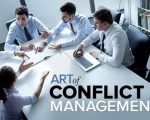
Group Conflict and Fragmentation
This stage is characterized by individuals within the group exerting themselves, or becoming determined. You can also look at the challenges of sub-group formation or leadership roles.
Power ...

The Five Steps to Conflict Resolution
Is there a correct way to handle conflict? What are the effects of poor conflict management? Conflict in the workplace might be inevitable, as employees have different personalities, ...

Conflict Management Techniques
Techniques below aim to help managers to understand the complexities of conflict management.
1. Be aware of conflict
2. Take a considered and rational approach to conflict
3. Investigate ...
Consider preventative strategies for the future
Think about the lessons that can be learned from the conflict and the way it was handled. What could be done better next time? How could you develop your conflict management skills? ...
Evaluate how things are going
Don’t assume that the issue has been finally resolved. Continue to keep an eye on the situation and evaluate
how well the solution is working. If the problem reappears it may be necessary ...
Implement what has been agreed
It is important to ensure that everyone is clear about what has been decided and takes personal responsibility for any actions which have been agreed. In some cases a written agreement ...
Identify options and agree on a way forward
This is the most important and often the most difficult part of the process. The following steps may be helpful
in reaching agreement:
› create an atmosphere where all parties are ...
Let everyone have their say
If you are able to get the parties together, you may be able to reach a satisfactory solution. Take a positive, friendly and assertive approach to the meeting and set ground rules for ...
Decide how to tackle the conflict
Having examined the situation, decide what kind of action is appropriate. Ask yourself:
› Is this a serious matter or relatively trivial? Could it become serious?
› Should organisational ...
Investigate the situation
Take time to find out what has happened, who is involved, how people are feeling, and what the issues are. Don’t pre-judge the issue or jump to conclusions. Speak individually and ...
